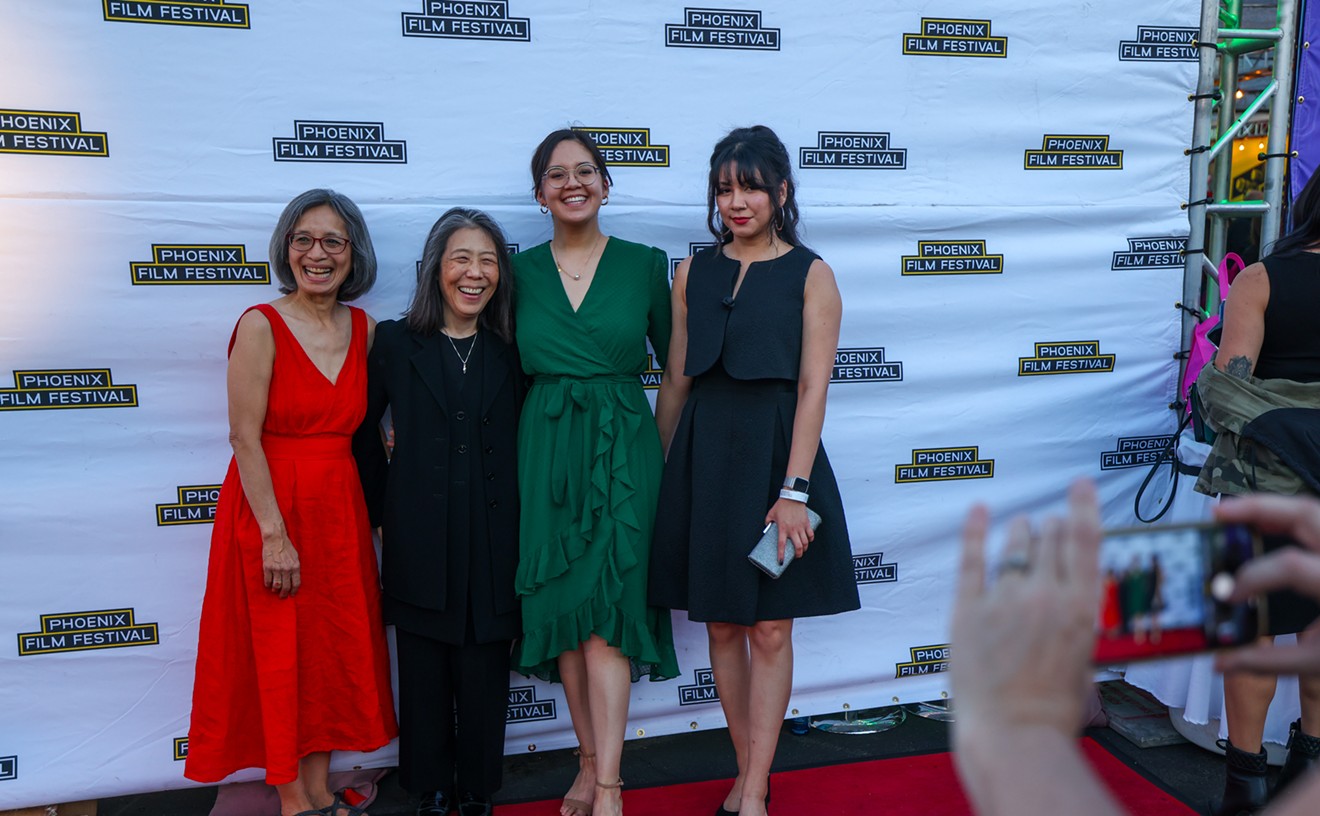"The Boneyard Project" at Pima Air and Space Museum in Tucson: In January, Eric Firestone and Carlo McCormick (with the help of a few heavy-machine-driving professionals) dragged three Super DC-3 planes, a C45, a Lockheed VC140, a C97 cockpit, and dozens of nose cones of the boneyard, a collection of dusty, non-functioning planes near Pima Air and Space Museum, and gave them a new life. The two are big-name curators in New York (though Firestone once operated a gallery in Arizona) and after seeing the pieces, they brought SMoCA's Lesley Oliver on board, enlisted a dream lineup of contemporary artists, and gave them the opportunity to paint on a very different kind of canvas. It was a massive and inspiring show that required a big budget, a tight timeline, a huge opening party, and an understanding that the large-scale pieces ultimately would be ephemeral works of art. After "The Boneyard Project" had its run at the museum, the nose cones traveled to Firestone's gallery, but the planes stayed in Tucson, perhaps left back in the boneyard to be rediscovered.
Jetsonorama's "Postcard" on Seventh Street: Jetsonorama is a longtime documentary photographer who creates black-and-white photographs in three-foot strips before pasting them onto roadside stands, water tanks, and billboards in Shonto, Arizona. In late 2011, the artist collaborated with Thomas "Breeze" Marcus on a billboard installation on 16th Street, and in January 2012, he printed an image that Brazilian photographer Raul Zito had captured in São Paulo and pasted it on Seventh Street (with details painted by Marcus) with just a ladder, a few buckets of wheat paste, and a small crowd of spectators. Jetsonorama called it a postcard, a tribute to Zito, who had pasted one of Jetsonorama's pieces in Brazil. And despite the ephemeral nature of the piece, you can still spot its remnants on the red brick building on Seventh Street, north of Roosevelt, with a few of Jetsonorama's signature sheep.
"Drawing with Thread" by Saskia Jorda at Scottsdale Civic Center Library: Artist Saskia Jorda spent much of the summer of 2012 at the Scottsdale Civic Center Library. Jorda was Scottsdale Public Art's artist in residence, and over the course of a month, she transformed the library's gallery into an intertwining maze of stretched white pantyhose and abstract yarn-wrapped bulbs that hung from the ceiling. Jorda described her installation as a "dialogue between body and space." And more than large-scale eye candy, Jorda's installation served as a frame in which Scottsdale Public Art held a number of workshops in conjunction with its "100+ Journals" project. In May, Jorda broke out her supply of thread and collection of maps and welcomed the public to explore line drawing, mapping, pattern, and texture with string on paper. The workshop was a rare opportunity to peek behind Jorda's process and obsession with cartography (though she'll admit she has a terrible sense of direction) in a very cool space.
Anthony Velasquez's "An Odd Kind of Sympathy" at Lisa Sette Gallery: In the spring, Scottsdale gallery owner and art community fixture Lisa Sette spotted work by Anthony Velasquez in a framing shop. Within months, she was hosting a series of his work and added him to her successful stable of artists. Velasquez might be new to the local fine arts scene, but he's been embedded in the urban arts scene since he was a kid growing up in Avondale. His mom owned an antiques shop, and because he was constantly surrounded by well-worn trinkets and décor, he grew an appreciation for age and craftsmanship, and that's clear in his work. At Lisa Sette Gallery, the artist hung a collection of still-life paintings that had warmth and a distinct ethereal quality. In each, five items — one for each of the five senses — were carefully balanced on top of one another and painted on dark walnut panels with an obsessive attention to detail. He called them "totems to human experience." I can't wait to see what he comes up with next.
Kyle Durrie's "Moveable Type Truck" at ASU: When the Phoenix AIGA design chapter announced it was bringing Portland-based artist and letterpress fiend Kyle Durrie to Phoenix, there was an audible squeal that came from somewhere deep inside the New Times building. Durrie's known for the traveling letterpress studio she built inside a 1982 Chevy van using funds raised on Kickstarter. Durrie parked outside the ASU art building in Tempe for an afternoon, told stories of her letterpress trip across the country, dubbed "Moveable Type," and gave her drooling fans a chance to create (and buy) a couple of posters. Movable eye candy, indeed.
"Cattle Track Couture" at Cattle Track: Dennita Sewell and Janie Ellis work very well together. Sewell is Phoenix Art Museum's curator of fashion design; Ellis runs Cattle Track, an artist compound in Scotts-dale. And though their daily lives look almost nothing alike, they were both raised by parents who were pioneers and craftspeople who built their own houses, farmed their own land, and, most important, made their own clothes. In March, the two opened the doors to Cattle Track for a special exhibition of handmade clothes by Janie's mother, Rachel, who crafted dresses, blouses, pants, and skirts for Janie and a number of theatrical productions around town. The show was beautifully presented: Clothes were fitted to forms Janie handmade and stuffed (which she'll tell you was no simple task), and a collection of fabrics Ellis used was on view for large groups of fashion-invested community members and art appreciators alike.
James Turrell's Skyspace in Tempe: As soon as the construction fencing around a mysterious glowing structure on ASU's Tempe campus came down, I drove down (in a lightning storm, no less) to see what all the rumbling was about. The glowing structure was the latest skypsace designed and built by Arizona artist James Turrell, along with Phoenix-based architect Will Bruder, who designed Burton Barr Library, Scottsdale Museum of Contemporary Art, and The Nevada Museum of Art (to name a few). Turrell's work relies on light and environment, and his series of Skyspace installations (including Knight Rise at Scotts-dale Museum of Contemporary Art) capture and frame the natural light and create a constantly changing visual experience for their viewers. His Skyspace in Tempe is a slight departure, in that Turrell relies both on the light of the sky and on man-made light and color reflected on the large-scale frame that's suspended by a metal structure surrounding the installation. The colors change periodically, and the best time to sit and watch the show is a half-hour before sunrise and/or sunset, when the color of the sky and the color of Turrell's frame change most dramatically — or in a lightning storm, when the colors, lights, and surroundings get really interesting.
Chaos Theory 13 at Legend City Studio: Randy Slack's Chaos Theory art show is always a spectacle. Once a year, the local artist clears the walls of Legend City Studios, which he owns with three photographers (Jason Grubb, John Balinkie, and Brandon Sullivan), and hangs dozens of pieces by local artists — usually in one 24-hour span. This year was especially notable, as Slack had to explain a few curatorial decisions to the community days before the big opening. But, as usual, the night went off with a bang and without a hitch. Hundreds crowded into the gallery to see work by more than 60 artists (about the closest we get to a Thursday night in Chelsea). They looked, they laughed, and they brought their kids, who climbed over each other (and around the artwork) to create one of Chaos Theory's most "community-centric" events since its inception.
Matteo Rubbi at Combine Studios: Italian artist Matteo Rubbi was an artist in residence with ASU Art Museum throughout 2012. You might have bumped into him making masks for young First Friday attendees, at "Magic Friday" dinners at the museum and in downtown Phoenix, or challenging the local view of how art can transform a space and the interaction between audience and gallery setting. His research, interactions, and creations during his time in Phoenix were center stage during November at downtown Phoenix's Combine Studios, where he discussed cultural aspects of mining in Arizona, urban transportation, and food as a bridge between people of different backgrounds. His show included work on copper, chalkboard drawing, mixed-media pieces, and a large-scale board game that Rubbi interpreted from a Jules Verne novel. His work is smart and refreshing, and his whimsical personality was something to be seen. Rubbi returned to Italy late this year, and now we just have to figure out how to get him to come back.
Carrie Marill's Tribute Mural in November: In March, hundreds of volunteers, Roosevelt Row staff members, and a group of local artists gathered on Roosevelt Street to build picnic tables, clean the sidewalks, and paint murals on a few of the neighborhood's buildings. Carrie Marill, whose art has traveled across the country (I spotted it in SoHo in April and at SMoCA in October) designed a large cyclist for the florist on Roosevelt and Third Street. It was a tribute to Margaret Kilgallen, a huge name and well-loved street artist who died in 2001. The man on an old-school cruiser with a striped top and a hefty baguette in his bike basket was immediately recognizable as Kilgallen-esque, and it drew a variety of responses from the community. Many loved it, but in November, the mural was defaced — painted over with huge red blocks of paint. Marill assumed whoever painted over it thought it was merely a rip-off, not a tribute. She thought about painting a different design, but I'm glad that instead, on the following day, Marill and a few volunteers bit back, grabbed a few more buckets of paint, and repainted the design in front of an audience on First Friday.










